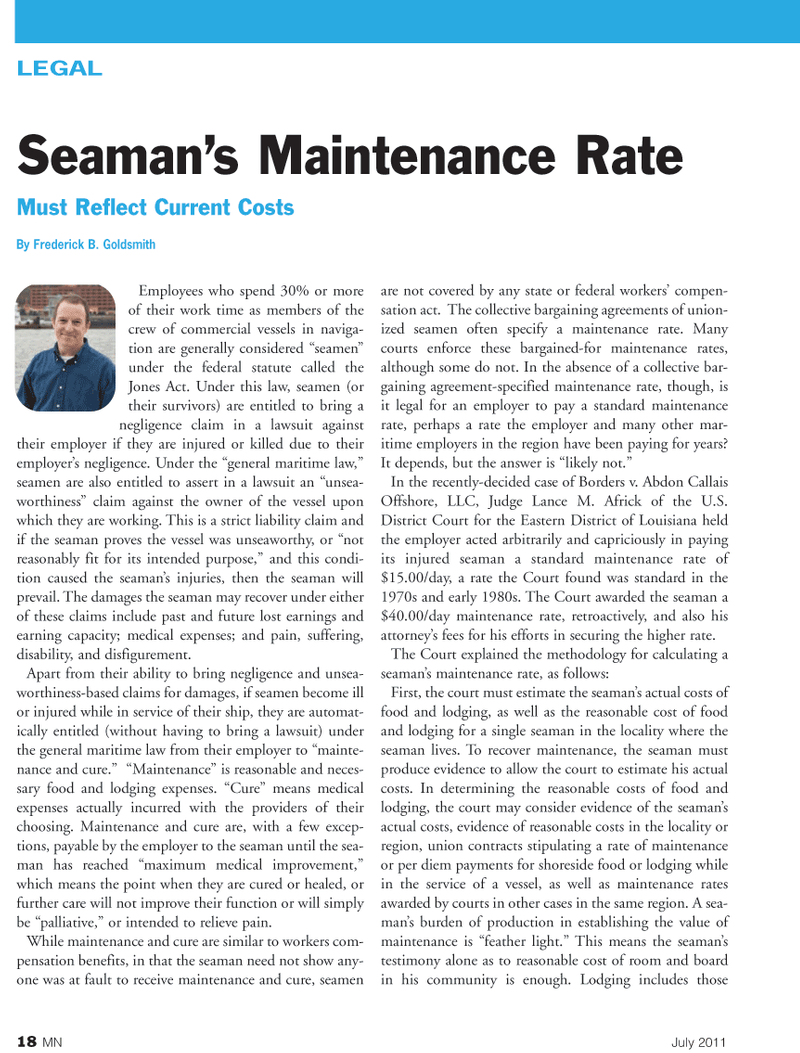
Page 18: of Marine News Magazine (July 2011)
Workboat Power
Read this page in Pdf, Flash or Html5 edition of July 2011 Marine News Magazine
18MNJuly 2011LEGALEmployees who spend 30% or more of their work time as members of the crew of commercial vessels in naviga- tion are generally considered seamen? under the federal statute called theJones Act. Under this law, seamen (or their survivors) are entitled to bring a negligence claim in a lawsuit againsttheir employer if they are injured or killed due to their employers negligence. Under the general maritime law,? seamen are also entitled to assert in a lawsuit an unsea- worthiness? claim against the owner of the vessel upon which they are working. This is a strict liability claim and if the seaman proves the vessel was unseaworthy, or not reasonably fit for its intended purpose,? and this condi- tion caused the seamans injuries, then the seaman will prevail. The damages the seaman may recover under either of these claims include past and future lost earnings and earning capacity; medical expenses; and pain, suffering,disability, and disfigurement. Apart from their ability to bring negligence and unsea- worthiness-based claims for damages, if seamen become ill or injured while in service of their ship, they are automat- ically entitled (without having to bring a lawsuit) underthe general maritime law from their employer to mainte- nance and cure.? Maintenance? is reasonable and neces- sary food and lodging expenses. Cure? means medical expenses actually incurred with the providers of their choosing. Maintenance and cure are, with a few excep- tions, payable by the employer to the seaman until the sea- man has reached maximum medical improvement,? which means the point when they are cured or healed, or further care will not improve their function or will simply be palliative,? or intended to relieve pain. While maintenance and cure are similar to workers com- pensation benefits, in that the seaman need not show any- one was at fault to receive maintenance and cure, seamen are not covered by any state or federal workers compen- sation act. The collective bargaining agreements of union- ized seamen often specify a maintenance rate. Many courts enforce these bargained-for maintenance rates, although some do not. In the absence of a collective bar- gaining agreement-specified maintenance rate, though, is it legal for an employer to pay a standard maintenance rate, perhaps a rate the employer and many other mar- itime employers in the region have been paying for years? It depends, but the answer is likely not.? In the recently-decided case of Borders v. Abdon Callais Offshore, LLC, Judge Lance M. Africk of the U.S. District Court for the Eastern District of Louisiana held the employer acted arbitrarily and capriciously in paying its injured seaman a standard maintenance rate of $15.00/day, a rate the Court found was standard in the 1970s and early 1980s. The Court awarded the seaman a $40.00/day maintenance rate, retroactively, and also his attorneys fees for his efforts in securing the higher rate. The Court explained the methodology for calculating a seamans maintenance rate, as follows: First, the court must estimate the seamans actual costs of food and lodging, as well as the reasonable cost of food and lodging for a single seaman in the locality where the seaman lives. To recover maintenance, the seaman must produce evidence to allow the court to estimate his actual costs. In determining the reasonable costs of food and lodging, the court may consider evidence of the seamans actual costs, evidence of reasonable costs in the locality or region, union contracts stipulating a rate of maintenance or per diem payments for shoreside food or lodging while in the service of a vessel, as well as maintenance rates awarded by courts in other cases in the same region. A sea- mans burden of production in establishing the value of maintenance is feather light.? This means the seamans testimony alone as to reasonable cost of room and board in his community is enough. Lodging includes thoseSeamans Maintenance Rate Must Reflect Current Costs By Frederick B. Goldsmith

 17
17

 19
19
